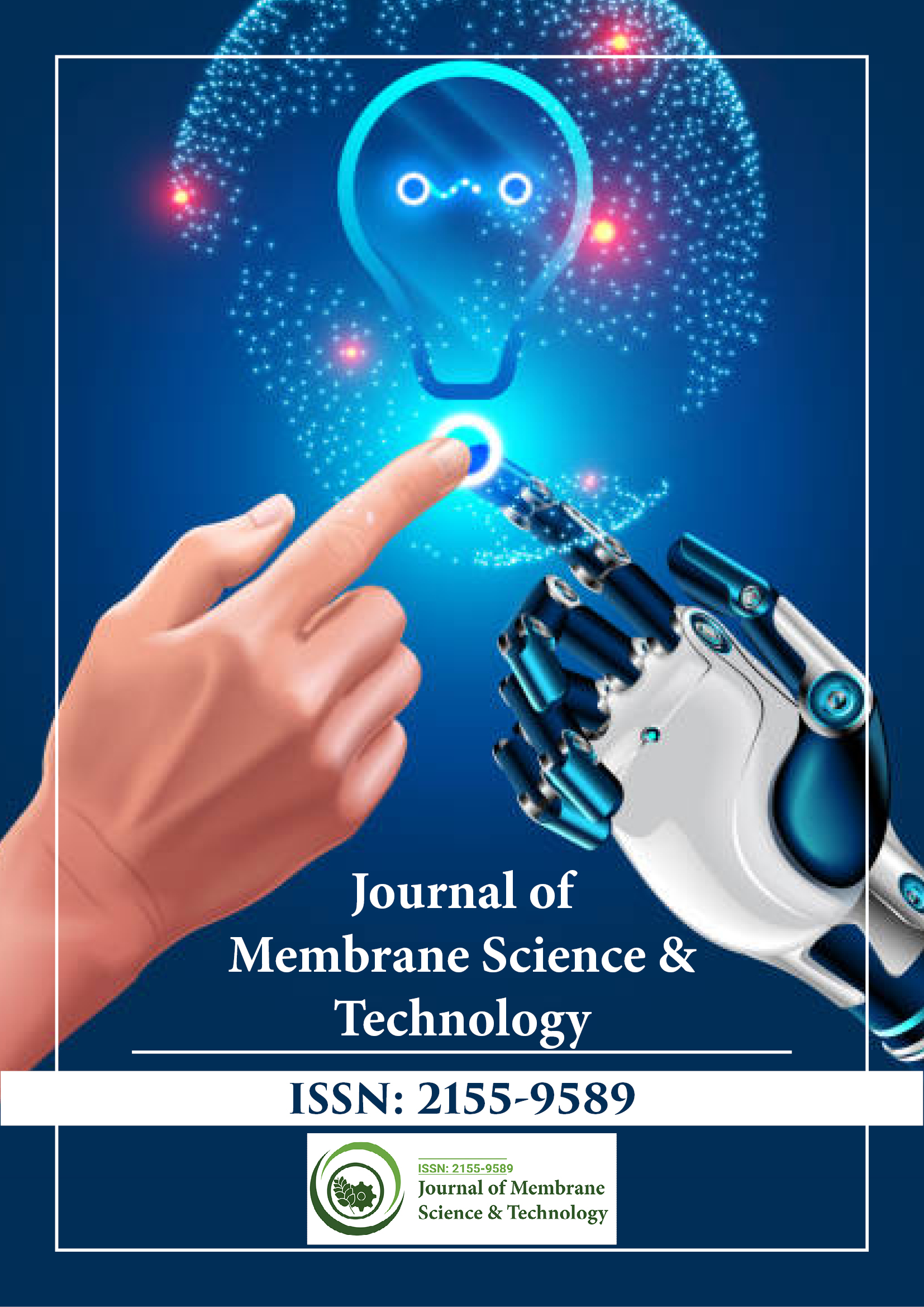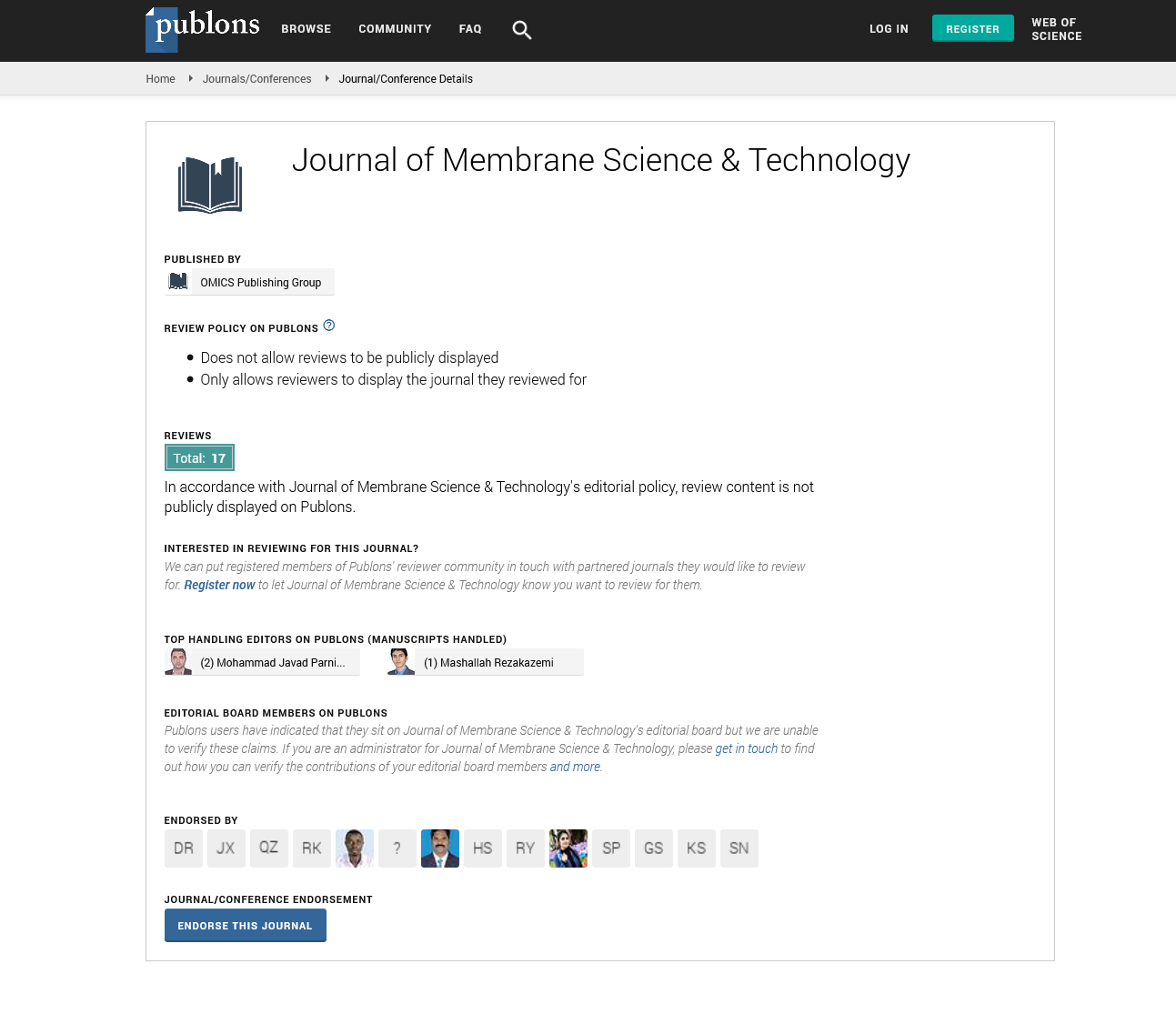Indexed In
- Open J Gate
- Genamics JournalSeek
- Ulrich's Periodicals Directory
- RefSeek
- Directory of Research Journal Indexing (DRJI)
- Hamdard University
- EBSCO A-Z
- OCLC- WorldCat
- Proquest Summons
- Scholarsteer
- Publons
- Geneva Foundation for Medical Education and Research
- Euro Pub
- Google Scholar
Useful Links
Share This Page
Journal Flyer

Open Access Journals
- Agri and Aquaculture
- Biochemistry
- Bioinformatics & Systems Biology
- Business & Management
- Chemistry
- Clinical Sciences
- Engineering
- Food & Nutrition
- General Science
- Genetics & Molecular Biology
- Immunology & Microbiology
- Medical Sciences
- Neuroscience & Psychology
- Nursing & Health Care
- Pharmaceutical Sciences
Commentary - (2025) Volume 15, Issue 1
Osmotic Distillation: A Novel Low-Temperature Separation Process for Liquid Concentration
Fabian Udugma*Received: 31-Jan-2025, Manuscript No. JMST-25-29271; Editor assigned: 03-Feb-2025, Pre QC No. JMST-25-29271 (PQ); Reviewed: 17-Feb-2025, QC No. JMST-25-29271; Revised: 24-Feb-2025, Manuscript No. JMST-25-29271 (R); Published: 03-Mar-2025, DOI: 10.35248/2155-9589.25.15.410
Description
Osmotic distillation is an emerging and innovative membrane-based separation process that offers a low-temperature alternative for concentrating liquid solutions. Unlike traditional distillation, which relies on thermal energy to achieve phase changes, osmotic distillation works through the selective transfer of water vapor across a hydrophobic membrane, driven by a vapor pressure difference. This mechanism makes it particularly suitable for processing temperature-sensitive materials, such as fruit juices, pharmaceuticals and biological fluids, where preserving flavor, nutrients, or molecular structure is critical.
At the core of osmotic distillation is a hydrophobic microporous membrane, typically made from materials like Polytetrafluoroethylene (PTFE) or polypropylene. This membrane acts as a barrier that allows only water vapor to pass while preventing the actual liquid from moving across it. The system operates with two primary liquids: the feed solution, which contains water and solutes to be concentrated, and the stripping solution, often a highly concentrated salt or brine solution with lower water vapor pressure. Water vapor from the feed side moves across the membrane to the stripping side because of the vapor pressure gradient, leaving solutes behind in the feed and thus concentrating it. Importantly, this transfer occurs without the need to raise the liquid to boiling temperatures, preserving thermally sensitive components and reducing energy consumption.
A typical osmotic distillation system includes several key components. The microporous hydrophobic membrane serves as the medium for vapor transfer. The feed and stripping solutions are stored in separate tanks, each equipped with circulation pumps to ensure continuous flow across both sides of the membrane. In some systems, heat exchangers are also integrated to maintain a steady and optimal temperature that supports the vapor pressure gradient. The modular design of these systems provides flexibility, making them suitable for both small-scale research and large-scale industrial applications.
One of the most compelling advantages of osmotic distillation is its ability to operate at low temperatures, often near ambient conditions. This is particularly beneficial in applications where maintaining the original sensory and nutritional quality of a product is essential, such as in fruit juice concentration or dairy processing. The process also demonstrates high selectivity, transferring only water vapor while retaining solutes and even volatile aromatic compounds in the feed. Compared to other separation methods, OD is relatively energy-efficient, as it avoids the use of high temperatures or pressures. Additionally, the hydrophobic nature of the membranes used reduces the risk of wetting and biofouling, common issues in other membrane processes like ultrafiltration and reverse osmosis. The technology is also capable of achieving high concentration levels without compromising product integrity, making it ideal for high-value liquid concentrates.
The application potential of osmotic distillation spans across several industries. In the food and beverage sector, it is increasingly used for concentrating fruit juices while preserving flavor, color, and vitamins. It also plays a role in dairy applications, such as concentrating whey and milk and can even be used to reduce alcohol content in beverages without significantly altering taste or quality. In pharmaceuticals and biotechnology, OD proves valuable for concentrating proteins and vaccines, where even minor temperature changes can lead to denaturation or degradation. The water treatment sector also benefits from OD, particularly in desalination plants where it helps to concentrate brine or recover clean water from wastewater. In the chemical industry, it can be used to concentrate organic acids, dyes, or solvents in a controlled and efficient manner.
Despite its many advantages, osmotic distillation does face certain limitations. Membrane wetting is one of the most significant challenges; if the membrane loses its hydrophobicity, the system’s performance declines sharply. There is also the risk of salt or contaminant carry-over if the membrane is damaged or breached. Maintaining a consistently high concentration of the stripping solution can be resource-intensive and requires careful management. Moreover, the process tends to be slower than pressure-driven alternatives like reverse osmosis, which may limit throughput for certain high-demand applications. These drawbacks have spurred ongoing research focused on enhancing the robustness, efficiency, and scalability of OD systems.
Recent advancements in the field are addressing many of these issues. New membrane materials with superior hydrophobic properties, chemical resistance, and optimized pore structures are being developed to increase longevity and resistance to fouling. Innovations in system design, such as hollow fiber and flat-sheet modules, help maximize surface area and minimize energy losses. Hybrid technologies that combine osmotic distillation with other membrane processes, like reverse osmosis or membrane distillation, are being explored to enhance overall efficiency and broaden operational capabilities. Moreover, improvements in flow control and temperature management are being used to increase the water vapor flux and make the process more economically viable.
From an environmental and economic standpoint, osmotic distillation aligns well with sustainability goals. Its low energy demand reduces greenhouse gas emissions compared to conventional thermal methods. However, its commercial viability depends on factors such as membrane cost, durability, and the feasibility of brine regeneration or disposal. In industries where preserving product quality is paramount, the advantages of OD often outweigh these concerns, offering both economic and environmental benefits through reduced waste, improved product shelf life and minimal degradation.
Conclusion
In conclusion, osmotic distillation represents a highly promising technology that bridges the gap between high-quality product concentration and sustainable processing. Its unique mechanism, which combines the principles of membrane separation and vapor pressure manipulation, provides a gentle yet effective way to handle sensitive liquids. As research and innovation continue to improve membrane performance and system design, osmotic distillation is expected to gain further prominence across a range of industries, including food processing, pharmaceuticals, chemical manufacturing and water treatment, helping to meet the growing global demand for efficient, low-impact separation technologies.
Citation: Udugma F (2025). Osmotic Distillation: A Novel Low-Temperature Separation Process for Liquid Concentration. J Membr Sci Technol. 15:410.
Copyright: © 2025 Udugma F. This is an open-access article distributed under the terms of the Creative Commons Attribution License, which permits unrestricted use, distribution, and reproduction in any medium, provided the original author and source are credited.

